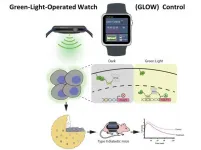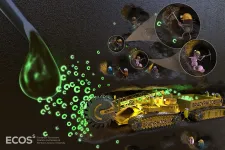(Press-News.org) CAMBRIDGE, MA -- MIT engineers have discovered a new way of generating electricity using tiny carbon particles that can create a current simply by interacting with liquid surrounding them.
The liquid, an organic solvent, draws electrons out of the particles, generating a current that could be used to drive chemical reactions or to power micro- or nanoscale robots, the researchers say.
"This mechanism is new, and this way of generating energy is completely new," says Michael Strano, the Carbon P. Dubbs Professor of Chemical Engineering at MIT. "This technology is intriguing because all you have to do is flow a solvent through a bed of these particles. This allows you to do electrochemistry, but with no wires."
In a new study describing this phenomenon, the researchers showed that they could use this electric current to drive a reaction known as alcohol oxidation -- an organic chemical reaction that is important in the chemical industry.
Strano is the senior author of the paper, which appears today in Nature Communications. The lead authors of the study are MIT graduate student Albert Tianxiang Liu and former MIT researcher Yuichiro Kunai. Other authors include former graduate student Anton Cottrill, postdocs Amir Kaplan and Hyunah Kim, graduate student Ge Zhang, and recent MIT graduates Rafid Mollah and Yannick Eatmon.
Unique properties
The new discovery grew out of Strano's research on carbon nanotubes -- hollow tubes made of a lattice of carbon atoms, which have unique electrical properties. In 2010, Strano demonstrated, for the first time, that carbon nanotubes can generate "thermopower waves." When a carbon nanotube is coated with layer of fuel, moving pulses of heat, or thermopower waves, travel along the tube, creating an electrical current.
That work led Strano and his students to uncover a related feature of carbon nanotubes. They found that when part of a nanotube is coated with a Teflon-like polymer, it creates an asymmetry that makes it possible for electrons to flow from the coated to the uncoated part of the tube, generating an electrical current. Those electrons can be drawn out by submerging the particles in a solvent that is hungry for electrons.
To harness this special capability, the researchers created electricity-generating particles by grinding up carbon nanotubes and forming them into a sheet of paper-like material. One side of each sheet was coated with a Teflon-like polymer, and the researchers then cut out small particles, which can be any shape or size. For this study, they made particles that were 250 microns by 250 microns.
When these particles are submerged in an organic solvent such as acetonitrile, the solvent adheres to the uncoated surface of the particles and begins pulling electrons out of them.
"The solvent takes electrons away, and the system tries to equilibrate by moving electrons," Strano says. "There's no sophisticated battery chemistry inside. It's just a particle and you put it into solvent and it starts generating an electric field."
Particle power
The current version of the particles can generate about 0.7 volts of electricity per particle. In this study, the researchers also showed that they can form arrays of hundreds of particles in a small test tube. This "packed bed" reactor generates enough energy to power a chemical reaction called an alcohol oxidation, in which an alcohol is converted to an aldehyde or a ketone. Usually, this reaction is not performed using electrochemistry because it would require too much external current.
"Because the packed bed reactor is compact, it has more flexibility in terms of applications than a large electrochemical reactor," Zhang says. "The particles can be made very small, and they don't require any external wires in order to drive the electrochemical reaction."
In future work, Strano hopes to use this kind of energy generation to build polymers using only carbon dioxide as a starting material. In a related project, he has already created polymers that can regenerate themselves using carbon dioxide as a building material, in a process powered by solar energy. This work is inspired by carbon fixation, the set of chemical reactions that plants use to build sugars from carbon dioxide, using energy from the sun.
In the longer term, this approach could also be used to power micro- or nanoscale robots. Strano's lab has already begun building robots at that scale, which could one day be used as diagnostic or environmental sensors. The idea of being able to scavenge energy from the environment to power these kinds of robots is appealing, he says.
"It means you don't have to put the energy storage on board," he says. "What we like about this mechanism is that you can take the energy, at least in part, from the environment."
INFORMATION:
The research was funded by the U.S. Department of Energy and a seed grant from the MIT Energy Initiative.
Many modern fitness trackers and smartwatches feature integrated LEDs. The green light emitted, whether continuous or pulsed, penetrates the skin and can be used to measure the wearer's heart rate during physical activity or while at rest.
These watches have become extremely popular. A team of ETH researchers now wants to capitalise on that popularity by using the LEDs to control genes and change the behaviour of cells through the skin. The team is led by Martin Fussenegger from the Department of Biosystems Science and Engineering in Basel. He explains the challenge to this undertaking: "No naturally occurring molecular ...
Levels of a protein called neurofilament light chain (NfL) in the blood can identify those who might have neurodegenerative diseases such as Down's syndrome dementia, motor neuron disease (ALS) and frontotemporal dementia, when clinical symptoms are not definitive.
Published in Nature Communications and part-funded by the NIHR Maudsley Biomedical Research Centre, the research determined a set of age-related cut-off levels of NfL which could inform its potential use in primary care settings through a simple blood test.
Joint Senior Author on the study, Dr Abdul Hye from the NIHR Maudsley Biomedical Research Centre at King's College London and South London and Maudsley NHS Foundation Trust said: 'For the first time we have shown ...
The first double-blind experiment analysing the role of human decision-making in climate reconstructions has found that it can lead to substantially different results.
The experiment, designed and run by researchers from the University of Cambridge, had multiple research groups from around the world use the same raw tree-ring data to reconstruct temperature changes over the past 2,000 years.
While each of the reconstructions clearly showed that recent warming due to anthropogenic climate change is unprecedented in the past two thousand years, there were notable differences in variance, amplitude and sensitivity, ...
NEW YORK, June 7, 2021--Recent studies suggest that new brain cells are being formed every day in response to injury, physical exercise, and mental stimulation. Glial cells, and in particular the ones called oligodendrocyte progenitors, are highly responsive to external signals and injuries. They can detect changes in the nervous system and form new myelin, which wraps around nerves and provides metabolic support and accurate transmission of electrical signals. As we age, however, less myelin is formed in response to external signals, and this progressive decline has been linked to the age-related cognitive and motor deficits detected in older people in the general population. Impaired ...
Just a few bacterial taxa found in ecosystems across the planet are responsible for more than half of carbon cycling in soils. These new findings, made by researchers at Northern Arizona University and published in END ...
In a white ocean, well above sea level, the algae thrive. Normally invisible to the naked eye, they are often spotted by hikers trekking through the mountains in late spring as strikingly coloured stretches of snow, in shades of ochre, orange and red. Known as "glacier blood", this colouring is the result of the punctual multiplication (or bloom) of the microalgae that inhabit the snow.
But apart from this impressive phenomenon, the life and organisation of mountain microalgae communities remains a secret. It is this still unknown ecosystem, now threatened by global warming, that needs to be explored. The ALPALGA* consortium aims to meet this challenge by organising and pooling research efforts on snow microalgae, and it has already received support from the Agence nationale ...
Mental health visits for new mothers were 30% higher during the COVID-19 pandemic than before the pandemic, particularly in the first 3 months after giving birth, found new research in CMAJ (Canadian Medical Association Journal). https://www.cmaj.ca/lookup/doi/10.1503/cmaj.210151
"Increased visit rates began in March 2020, although the state of emergency was declared only midway through the month, suggesting that distress related to the pandemic translated into an increased need for care very quickly," writes Dr. Simone Vigod, chief of psychiatry, senior scientist and interim vice president of academics at Women's College Hospital (WCH), and senior adjunct scientist at ...
New research indicates that patients hospitalized with active cancer were more likely to die from COVID-19 than those with a history of cancer or those without any cancer diagnosis. The findings published by END ...
A traditional Vietnamese meat snack could hold the key to developing a safe and natural food preservative, addressing the twin global problems of food waste and food-borne illnesses.
Key Points
Bacteria-killing compound discovered in Nem Chua, a fermented pork snack
Toxic to bacteria but safe for humans, it's a natural alternative to artificial food preservatives
New study reveals ideal growth conditions to potentially make the bacteria-killer at industrial scales
The fermented pork snack, Nem Chua, is eaten raw but does not cause food poisoning when prepared correctly.
This is because friendly bacteria that thrive in the fermented meat make a special compound that destroys more dangerous bacteria.
Now ...
Once viewed merely as a producer of the cerebrospinal fluid (CSF) bathing the brain and spinal cord, the choroid plexus is now known to be a key player in brain development and immunity. These fronds of brain tissue, located in the CSF-filled brain cavities known as ventricles, secrete instructive cues into the CSF to regulate brain development. They also function as an important barrier between the brain and the rest of the body.
Maria Lehtinen, PhD, of Boston Children's Hospital has done much of the pioneering work in understanding this once-obscure tissue. In new work published in Cell, Lehtinen, Neil Dani, PhD, and other colleagues at Boston Children's and the Broad Institute created ...




